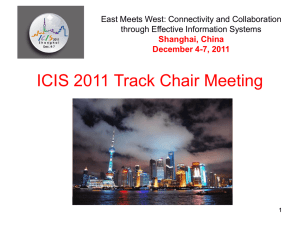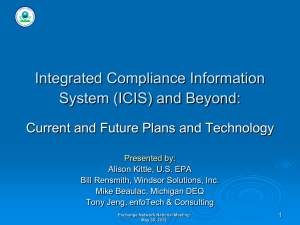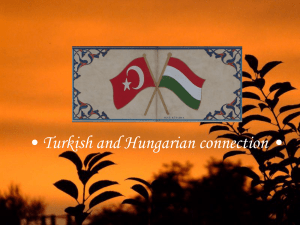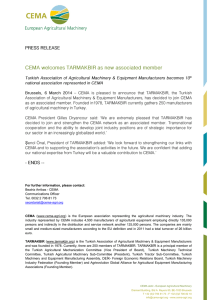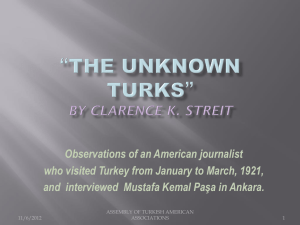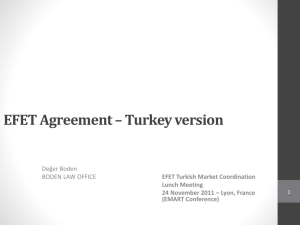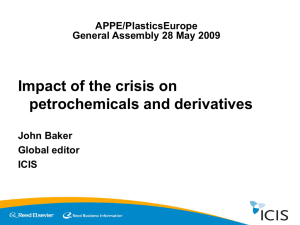Price Structure - ICIS Heren
advertisement
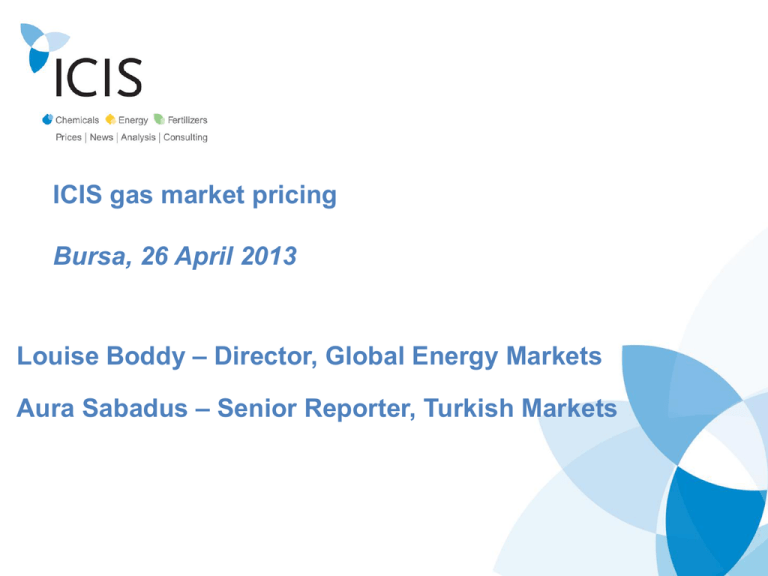
ICIS gas market pricing Bursa, 26 April 2013 Louise Boddy – Director, Global Energy Markets Aura Sabadus – Senior Reporter, Turkish Markets Contents 1. Introduction to ICIS 2. Evolution of European gas markets and pricing 3. ICIS Turkish market coverage 4. ICIS Turkish gas pricing trials and methodology www.icis.com 1. Introduction to ICIS www.icis.com Corporate structure • ICIS is the energy and chemicals information division and the fastest growing business within Reed Business Information (RBI). • RBI is a powerful business-to-business publisher. It is part of parent company Reed Elsevier. • World’s third largest professional information company (after Google and Thomson Reuters). Global leader in Science, Medical, Legal, Risk and Business data services, and Exhibitions. Employs over 35,000 people worldwide. Annual revenues of over £6bn in 2011. www.icis.com ICIS – reporting on and analysing energy, chemical and fertiliser markets. Over 600 staff globally. Moscow London New York Germany Washington Yantai Houston Shanghai Guangzhou Mumbai Singapore www.icis.com 2. Evolution of European gas markets and pricing www.icis.com History of gas price reporting 19 years of ICIS gas prices – first to bring price transparency into every new market 1994 – Heren Energy (now ICIS) started pricing UK gas trade, assessing Bacton and St. Fergus beach trade before the virtual hub was created. 1996 – Network Code launched, creating the NBP traded market. 1998 – First pipeline to continental Europe. ICIS starts first price assessments outside UK at Zeebrugge. 2005 – First LNG cargoes arrive in the UK at Isle of Grain. 2006 – ICIS launches global LNG reporting and the first Asian LNG spot price assessment in 2007. 2005-2008 - new European assessments started every year as trading spreads. NOW - 700-1000 primary prices published every day. 193 for European gas. www.icis.com Market Characteristics evolution phase Suitable pricing methodologies FORMATIVE Low liquidity, low numbers of counterparties, little standardisation, no brokers, wide bid/offer spreads, contradictory price signals. • Assessment. IMMATURE Medium liquidity, growing number of regular counterparties (>20), narrowing bid/offer spreads • LIQUID High liquidity , steady number of • Assessment. regular counterparties (<20), • Trades-based index over long narrow bid/offer spreads every day periods (all day/all month). on a range of contracts. MATURE High liquidity on spot and curve • Assessment. contracts, steady number of • Trades-based index over long regular counterparties (<30), periods (all day/all month). narrow bid/offer spreads every day • Trades-based index over short on a range of contracts, derivative periods (5-30 minutes). trade developed. www.icis.com Assessment. European gas hubs by development phase IMMATURE FORMATIVE Turkey Spain (AOC) Poland Czech Republic Austria (CEGH) Italy (PSV) LIQUID Germany (NCG) Germany (GASPOOL) MATURE France (PEGS) Belgium (Zeebrugge) Britain (NBP) Netherlands (TTF) www.icis.com Oct-12 Jul-12 Apr-12 Jan-12 Oct-11 Jul-11 Apr-11 Jan-11 Oct-10 Jul-10 Apr-10 Jan-10 Oct-09 Jul-09 Apr-09 Jan-09 Oct-08 Jul-08 Apr-08 Jan-08 Oct-07 Jul-07 Apr-07 Jan-07 Oct-06 Jul-06 Apr-06 Jan-06 Oct-05 Jul-05 Apr-05 Jan-05 Oct-04 Jul-04 Apr-04 Jan-04 Oct-03 Pan-European hub trade volume 2003-2012 Source: Transmission System Operators GWh/month 80000 70000 60000 50000 40000 30000 20000 10000 0 www.icis.com Tradability index by hub 2007-2013 This measures bid/offer spread availability, not volume Source: ICIS European Gas Hub Report 20 18 16 14 TTF Zeebrugge 12 NBP GASPOOL 10 PEG Nord NCG 8 PSV 6 CEGH Czech 4 2 0 Q3 '07 Q1 '08 Q3 '08 Q4 '08 Q3 Q4 '09 Q1 '10 Q2 '10 Q3 '10 Q4 '10 Q1 '11 Q2 '11 Q3 '11 Q4'11 Q1'12 Q2'12 Q3 '12 Q4 '12 Q1 '13 '09* www.icis.com Many hub contracts have consistent high liquidity Number of trades going into the ICIS front-month indices 12000 10000 8000 6000 TTF NBP NCG 4000 Zee 2000 0 www.icis.com ICIS prices are the most widely used benchmarks in Europe Built into many contracts. The most reliable measure of physical traded value: 1. In high volume, long-term, pipeline and LNG supply contracts. 2. In short and medium term supply contracts. 3. In floating-price end-user contracts. 4. Infrastructure operators’ capacity sale and auction contracts. 5. In Energy Trading and Risk Management Systems. 6. In physically settled derivative contracts. Used as a reference price by many different business functions: 7. As a starting point for negotiations. 8. In valuation of assets. 9. In strategic planning. www.icis.com 3. ICIS Turkish market coverage www.icis.com Price reporting What is price discovery? Just that. It seeks to determine a reliable price for a specific contract at a specific moment in time by talking directly to a wide section of the market. Why is it useful? It brings transparency It gives coherence to the market It helps to minimise risk www.icis.com Developing spot and balancing gas prices for Turkey • Tests carried out weekly for day 7 ex-post (“day after”) prices from 30 November (start day of test 6 December) • Tests carried out daily for day 7 ex-post prices from 31 December (start day of test 7 January) • Tests carried out daily for day-ahead prices from 12 March (start date of test 11 March) www.icis.com Test details – who was approached? www.icis.com How is the test conducted? • An average of five different companies submit prices to ICIS on a daily basis • Around one third of our communication is done via e-mail • Two thirds by phone • Companies are contacted between 11:00-14:00 for Day-ahead and throughout the day for ex-post deals • Average call duration 5 minutes www.icis.com Test findings www.icis.com Reporting trades and swaps… www.icis.com www.icis.com www.icis.com Challenges – Collecting data AT THE BEGINNING • Confusion over day-ahead, day-after prices and trades • Reluctance to report higher volumes • Reluctance to confirm the counterparty NOW • Reluctance to confirm counterparty • Ensuring that companies submit trade prices or bid-offer spreads www.icis.com Intrinsic market challenges • Natural gas volumes tied up in TOP contracts – hence little liquidity on the market, particularly for day-ahead trading • BOTAS book closure – what happens afterwards? • Stamp tax – a market killer www.icis.com www.icis.com www.icis.com www.icis.com www.icis.com Stamp tax – kills the market • Jeopardises security of supply • Deters investors • Fractures the market • Drives financial trading to other jurisdictions that are not covered by the tax. Turkish companies interested in speculation could, in theory, trade in the UK • Seriously affects Turkey’s ambition of becoming an energy and financial hub www.icis.com Reliability of day-after and day-ahead Turkish gas prices • Good reflection of market views (importers and wholesalers). Comparison between Turkish and Czech gas markets. • Avoiding manipulation through cross-checking trades, bidoffer spreads, mid points with other companies. • Assessments done in a transparent manner • Bring consistency to the market and visibility to traders www.icis.com Sooner or later? Developing Turkish gas prices • Bringing liquidity to the market: the “Turkish Airlines” effect. Where Turkish Airlines fly, business follows • Crucial to investors • Need to offer a south-eastern counterbalance to the north west European hubs and reach out to the Middle East and the Caspian region www.icis.com www.icis.com www.icis.com Price visibility is crucial to investors Spot prices bring: • Transparency • Flexibility www.icis.com T-Hub is vital for southeast Europe, Middle East & Caspian region GTF NBP TTF GASPOOL ZEE NCG Czech PEGs AOC VTP PSV T-HUB www.icis.com Thank you! Aura Sabadus + 44 (0) 207 911 1853 aura.sabadus@icis.com Louise Boddy +44 (0) 207 911 1928 louise.boddy@icis.com www.icis.com
